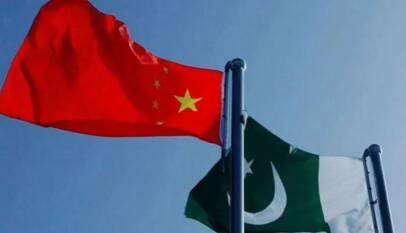Compared to August 2019, Pakistan Cotton Yarn exports increased by $32.244m in August 2020
Pakistan has exported 41.836 million US dollars worth of cotton yarn to China in August this year, which is 4.36 times the 9.592 million US dollars in the same period last year, with a year-on-year increase of 32.244 million US dollars i.e 336 percent increase. The reason cited for this increase is that Pakistan mainly produces low-count sirospun yarns, such as those of 8s or 10s, generally below 21s. The surge in import also lies in the fact that Pakistan’s yarn export to China enjoys zero-tariff. Moreover, Pakistani yarn is much cheaper than the Chinese one, the largest gap reached RMB 2,000 to 3,000 per ton in the last two years, with a price gap of about 10%.
BEIJING, (APP – UrduPoint / Pakistan Point News – 1st Oct, 2020 ):China has imported 41.836 million US dollars worth of cotton yarn from Pakistan in August, which is 4.36 times the 9.592 million US dollars in the same period last year, with a year-on-year increase of 336 percent, as per data from China’s General Administration of Customs.
To find out the fact behind the substantial growth of Pakistan’s cotton yarn export to China, China Economic Net visited 2020 Autumn Joint Exhibition of China National Textile and Apparel Council in Shanghai and talked to various importers.
Huang Xifeng, sales executive of import and export department at Litai Xingshi (Taicang) Holding Co Ltd informed that Pakistan mainly produces low-count sirospun yarns, such as those of 8s or 10s, generally below 21s, which are mostly imported to south China’s Guangdong province to be made into denim.
“We imported about 1,000 tons of cotton yarns from Pakistan every year. Our denim fabric is made of thick and low-count yarns, which are basically 10s or 8s, no more than 12s.” Yang Bin, director of Seazon Textile and Apparel Co Ltd in Foshan, China, said in an interview. The fabric woven with higher-count yarns is thinner and softer.
Yang said he has cooperated with Pakistan’s cotton yarn manufacturers for 10 years. “As for Pakistan’s cotton yarn, we only imported it from Explorer, a Pakistani manufacturer, with which we have cooperated for more than ten years.
Produced locally in Pakistan with American and Australian cotton as raw materials, it boasts the best quality of all. And yet, most of the other Pakistani producers adopt locally grown cotton, which may save RMB hundreds per ton. Although Pakistani cotton is somewhat of inferior quality to that in America, Australia, and China, it can be made into denim,” Yang said.
The main reason for the surge in import lies in the fact that Pakistan’s yarn export to China enjoys zero tariff, thus having a greater competitive advantage internationally. That’s why we prefer Pakistani cotton yarn even when offered the same price, said Ke Jiangwei, general manager of Xiamen Naseem Trade Co Ltd, which has been importing Pakistani yarn for many years in China.
“It is not just tariffs, but the price that attracts us,” said Yang, adding that “as Pakistani yarn is much cheaper than the Chinese one, the largest gap reached RMB 2,000 to 3,000 per ton in the last two years, with a price gap of about 10%. Due to the COVID-19 epidemic this year, domestic cotton yarn cannot sell well in China, thus narrowing the price gap to about RMB 1,000.” At present, China’s domestic cotton yarn inventory is relatively low, and some traders have a hoarding mindset. Ke analyzed that the inventory of cotton yarn has been reduced very quickly in the past week or two. “On the one hand, there is a lot of demand. Foreign orders, which had been held back for too long, have been gradually released. On the other hand, everyone thinks that the price of cotton yarn is very low now. Considering that clothing is a product concerning people’s livelihood, everyone wants to stock up when the price is relatively low.
” “The sirospun of 8s in Pakistan was RMB 17,000 or RMB 18,000 per ton before, and now it has dropped to about RMB 16,000 per ton. Given that prices are too low right now but they’re not going to keep going down, we stocked up at the low point,” Yang said.
At present, the price of Pakistani yarn in China’s domestic market has rebounded. It has risen by more than ten percent compared with the price in May and June. It may have been sold for RMB 15,000 per ton before, and now RMB 16,500, or even RMB 17,000. The price gap is as high as RMB 1,000-2,000 over the past three months,” Ke explained.
In the field of denim fabrics, will China increase imports and use of Pakistani yarn in the future? In this regard, Yang said that China’s domestic denim fabrics are relatively variable according to specific orders, so sticking to one kind of cotton yarn would be risky.
“Most jeans today are made of stretch fabric, which mainly uses Chinese yarns. Pakistan mainly produces flat yarns, which are a kind of warp yarns and cannot be made into elastic denim, while weft yarns and slub yarns used in denim are not available in Pakistan.” On the other hand, Yang introduced that many clothing enterprises are doing fast spinning this year via live streaming. Finished clothing needs to be delivered within 15 days after users place an order, so most garment factories purchase off-the-shelf fabrics. As a consequence, the time left for fabric processing factories is also limited. “The fabric should be produced within a week, otherwise garment factories will barely have time in manufacturing. Therefore, we mainly purchase cotton yarns in stock, and it will be too late to order them from Pakistan.” So how can the export potential of Pakistani cotton yarn be improved? Does the Chinese market still need Pakistani cotton yarn? “For example, 8s and 10s cotton yarns from Pakistan are currently in great demand in Lanxi City, east China’s Zhejiang Province. A factory with more than 200 looms can manage 200-300 tons of cotton yarns,” He Hao, a salesperson from Shengzhou Shengtai Haobang Textile Co., Ltd. Company, said.
Since China mainly produces high-count yarns, the output of such low-count yarns cannot meet China’s domestic demand, He explained. “I don’t know if there is an organization abroad dedicated to matching supply with demand.” Meanwhile, He suggested that Pakistan could try to produce cotton yarns with mixed cotton through a new technique called rotor spinning.
“Our traditional peak season is coming. The fabrics for autumn and winter are thicker so more yarns are required. We may consume twice the amount of yarns then as compared in the rest of a year. For example, it used to be only one ton, but now it needs two tons.
Pakistani cotton spinning products are what we need for a long time, so will continue to import them as long as they can be consumed in China’s factories and their prices are acceptable,” Ke said.
CPEC’s Success Story: $25 Billion Invested Across 38 Completed Projects
ISLAMABAD: A total of 38 projects worth over $25 billion have been completed and 23 develo…












